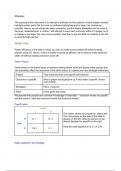Summary
Summary Notes for "Micro 3: Information Economics" Tilburg University
- Course
- Institution
The summary is based off ALL video lectures, slides, and readings. All core concepts are covered in this document with detailed explanations. Knowing the material in this summary will allow one to confidently enter the exam and achieve the grades desired. Personal grade achieved using this summary:...
[Show more]



